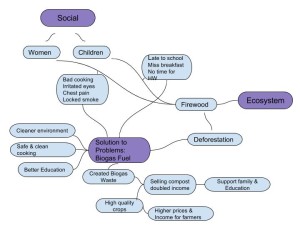In my diagram I focus on how people use India’s resources to find a solution to the harmful problem of cooking on stoves. This relates to the concept in module 2, human-environment landscape, which displays how humans affect the environment and the environment affects humans. In this case the environment is negatively affecting society, more specifically, women and children. My diagram displays that women order their children to collect firewood which inevitably leads to children missing breakfast, being late to school, and not having enough time to do their homework, while also creating unsafe and unsanitary cooking conditions in the house. People suffer from irritated eyes and chest pains from the locked smoke in the house. To fix this danger the environment caused, experts decided to create Biogas Fuel Technology. This technology creates safer and cleaner cooking conditions, a cleaner environment, and allows kids to have time for their education. Additionally, this fuel creates waste that women use to sell to farmers to help support their family and education, doubling their income. This allows farmers to improve their crops and earn a greater profit. This is an example of human-environment landscape because society altered their environment to create a safer living.
When comparing my diagram to Figure 1.5 there are a few similarities and differences. Even though Figure 1.5 displays a broader version than my diagram, both figures display how the social system affects the ecosystem and how the ecosystem affects the social system. However, Marten’s diagram focuses more on the population social ranking. For example the Marten explains the generators will mainly go to the wealthy rather than the poor, creating a wider gap between the two groups, which will not totally prevent the current problem of deforestation. On the other hand, my diagram focuses on how society as a whole is improving. Analyzing Figure 1.5 allowed me to have a different perspective on this concept, from seeing a different thought-process. I think that both my diagram and Marten’s diagram are correct, however, they differ due to different interpretations of the video.


Hey Samantha! My name is Cassandra Oresko and I was very interested in your blog because of the importance you showed on the resources India can use to protect their health. In my post as well, I mentioned the human-environment and how both humans and the environment affect each other. By eliminating locked smoke from homes, India can decrease the amount of itchiness in their eyes, chest/cough pains, as well an overall better health status. In contrast, you mentioned in your diagram how compost will lead to higher quality crops, but this will lead to higher priced crops. I didn’t think about this concept until you mentioned it; this could be difficult for working class Indians who are unable to afford higher cost crops. Though compost will lead to more jobs, hopefully higher priced crops will not be an issue for India. This was a very intelligent thought that I never took into consideration!
Attached is the link to my blog entry!: http://geog030.dutton.psu.edu/author/cao5241/
Hi! I like that you related this directly to the human-environment landscape because this is an example of how the environment affects humans and how humans had to alter the environment. I found your diagram interesting simply because it was a different way of setting it up compared to mine which had two different sides. However, I like how you related the ideas in this type of arrangement. I thought it was very clear how the biogas generator solved the problem and was beneficial to the human environment.
Here is a link to my post: https://wp.me/p3RCAy-aZV